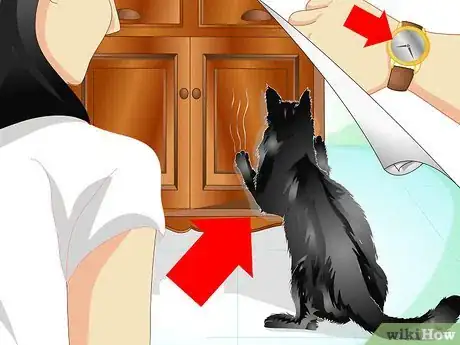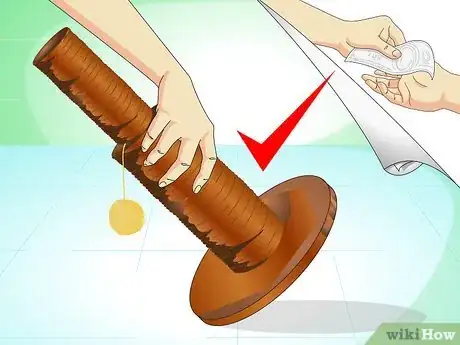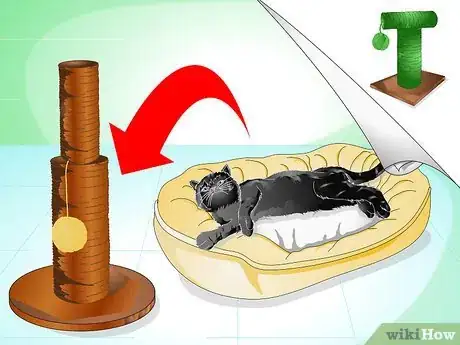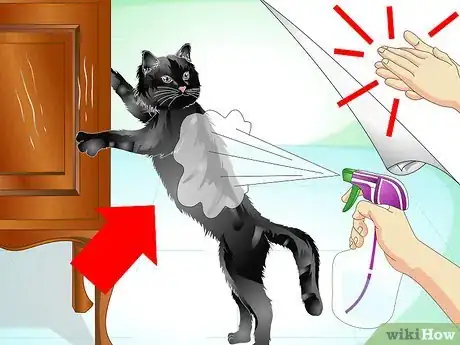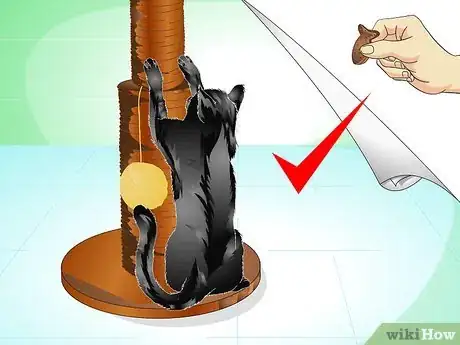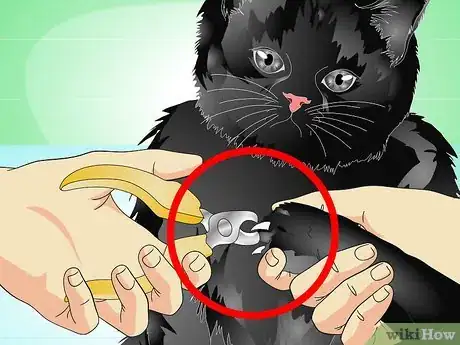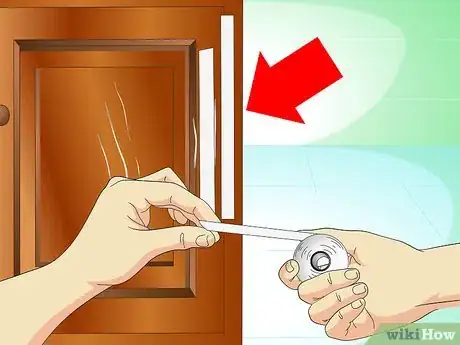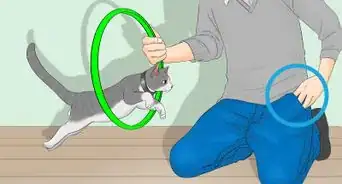This article was co-authored by Brian Bourquin, DVM. Brian Bourquin, better known as “Dr. B” to his clients, is a Veterinarian and the Owner of Boston Veterinary Clinic, a pet health care and veterinary clinic with three locations, South End/Bay Village, the Seaport, and Brookline, Massachusetts. Boston Veterinary Clinic specializes in primary veterinary care, including wellness and preventative care, sick and emergency care, soft-tissue surgery, dentistry. The clinic also provides specialty services in behavior, nutrition, and alternative pain management therapies using acupuncture, and therapeutic laser treatments. Boston Veterinary Clinic is an AAHA (American Animal Hospital Association) accredited hospital and Boston’s first Fear Free Certified Clinic. Brian has over 19 years of veterinary experience and earned his Doctor of Veterinary Medicine from Cornell University.
This article has been viewed 61,269 times.
Having a cat for a companion can be very fulfilling, but some cats also have bad habits that can be hard to break. Cats who scratch furniture are expressing a feline instinct to sharpen and use their claws. Even though this behavior is completely normal, it can also be frustrating and costly when the sides of your favorite couch are shredded by sharp cat claws. There are several things you can try to break your cat of this annoying feline habit.
Steps
Offering Other Options
-
1Pay attention to what your cat scratches and when. Typically, cats scratch to mark their territory, sharpen their claws, and stretch their bodies.[1] Pay attention to when and what your cat likes to scratch to figure out how to offer a suitable replacement that will be equally enticing.[2]
- Many cats have a preferred place and time to scratch, like right after a nap or when you come home. They also have preferences for the type of texture they like to scratch (often some type of nubby fabric that gives just the right amount of resistance).
-
2Buy a scratching post. Giving your cat somewhere else to scratch will make it less likely to scratch where it's not supposed to.[3] Look for something that is as similar in texture to your furniture as you can find (including density and roughness of fabric). In many cases, cats prefer a scratching post that is similar in texture to tree bark.
- There are many products available, including some that are infused with catnip. You an also rub catnip into any type of scratching toy.[4]
Advertisement -
3Put the post in a strategic position. Since you've observed your cat's habits, you are familiar with when and where she feels the urge to scratch. You should put the post somewhere that is convenient for her. For example, if she prefers to stretch on a post after a nap, put a scratching post near her bed. [5]
- You might buy a couple of different types of scratching posts and put them in different places, especially if you have more than one cat. Place a post in every room that she frequents so that she won't be overcome with the urge to scratch furniture there instead.[6]
Training the Cat
-
1Stop her. If you see your cat in the act of scratching on your furniture, stop her immediately and scold her. Clap your hands suddenly or spray her with water. Then, physically remove her from the area.[7]
- You can also use a remote deterrent, such as a motion-activate can of compressed air that will spurt at your cat she starts to scratch. This will deter a cat that won't scratch while you're there, but will start as soon as you're gone.
- Pick her up and move her to her scratching post. This will help her associate her urge to scratch with the post.
- Unless you catch her in the act, scolding won't help. She won't know what you're talking about.
-
2Reward good behavior. Cats, like dogs and like people, thrive on positive reinforcement for good behavior. Instead of punishing your cat for scratching the furniture, reward her for scratching the post.[8] You can offer any reward that you know she likes. Many cats respond well to the following:
- Praise. Cats love your attention more than anything. Scratch her ears, tell her what a good girl she is, and use a sweet, affectionate tone of voice.
- A cat treat. Offer her a favorite treat as a thank-you for scratching the post.
- Catnip. This can be rubbed into the scratching post or used as a reward for after she has scratched there.
-
3Don't yell. Most cats and kittens are annoyed by yelling, but it doesn't do much to deter their bad behavior.
- Yelling only teaches your cat to avoid you because you are unpredictable and maybe even dangerous.[9]
Deterring Your Cat From Scratching
-
1Trim her nails. One reason cats scratch furniture is to wear off the ends of their nails, which in the wild would wear down naturally from climbing and catching prey. If you keep her nails trimmed, she will have less of a physical need to scratch.[10]
- You can use special cat claw clippers from the pet store, or a pair of human nail clippers or small scissors. Cat claws are retractable, so you have to access the claws to trim them. Holding your cat's paw, gently press on the knuckle just behind the claw to cause the claw to extend from the paw. Very carefully trim off the very tip of the claw, but no more than that. Be sure to do both front paws about every ten days[11] and both back paws as needed.[12]
- If you are uncomfortable with trimming her nails, ask a groomer or veterinarian to show you how.
-
2
-
3Deter her with scent. Cats naturally avoid certain scents like citrus or menthol, so you can use this to your advantage by putting these types of scents near the area she likes to scratch to deter her behavior.[15]
- You can use essential oils on a cotton ball, or you can even buy spray products that are specifically formulated to deter cats and spray items you don't want your cat getting on. There are even natural products in health food stores.
-
4Give your cat interesting things to do. Sometimes cats scratch simply from boredom, so provide plenty of cat toys and other stimulating activities to keep her occupied.
- You don't have to spend any money; cats are fascinated with simple things like a cardboard box or paper bag. Set out a box or paper bag for her and watch her have fun.
Expert Q&A
-
QuestionHow can I get my cat to use the scratching post?
 Brian Bourquin, DVMBrian Bourquin, better known as “Dr. B” to his clients, is a Veterinarian and the Owner of Boston Veterinary Clinic, a pet health care and veterinary clinic with three locations, South End/Bay Village, the Seaport, and Brookline, Massachusetts. Boston Veterinary Clinic specializes in primary veterinary care, including wellness and preventative care, sick and emergency care, soft-tissue surgery, dentistry. The clinic also provides specialty services in behavior, nutrition, and alternative pain management therapies using acupuncture, and therapeutic laser treatments. Boston Veterinary Clinic is an AAHA (American Animal Hospital Association) accredited hospital and Boston’s first Fear Free Certified Clinic. Brian has over 19 years of veterinary experience and earned his Doctor of Veterinary Medicine from Cornell University.
Brian Bourquin, DVMBrian Bourquin, better known as “Dr. B” to his clients, is a Veterinarian and the Owner of Boston Veterinary Clinic, a pet health care and veterinary clinic with three locations, South End/Bay Village, the Seaport, and Brookline, Massachusetts. Boston Veterinary Clinic specializes in primary veterinary care, including wellness and preventative care, sick and emergency care, soft-tissue surgery, dentistry. The clinic also provides specialty services in behavior, nutrition, and alternative pain management therapies using acupuncture, and therapeutic laser treatments. Boston Veterinary Clinic is an AAHA (American Animal Hospital Association) accredited hospital and Boston’s first Fear Free Certified Clinic. Brian has over 19 years of veterinary experience and earned his Doctor of Veterinary Medicine from Cornell University.
Veterinarian There are actually products out there that you can buy and apply to the scratching post that will attract your cat to it so it's less likely to scratch elsewhere.
There are actually products out there that you can buy and apply to the scratching post that will attract your cat to it so it's less likely to scratch elsewhere.
Warnings
- Having an indoor cat always puts your furniture and other items at risk of being scratched, so don't leave a cat alone with antique, heirloom, or other meaningful items that you cannot replace. Even a trained cat sometimes resorts to scratching.⧼thumbs_response⧽
- Do not declaw your cat. This is a cruel process that involves amputating the ends of a cat's toes. Some veterinarians still recommend this procedure, but there are other ways to train your cat that are more humane.[16]⧼thumbs_response⧽
References
- ↑ Brian Bourquin, DVM. Veterinarian. Expert Interview. 20 December 2019.
- ↑ http://www.humanesociety.org/animals/cats/tips/destructive_scratching.html
- ↑ Brian Bourquin, DVM. Veterinarian. Expert Interview. 20 December 2019.
- ↑ http://www.humanesociety.org/animals/cats/tips/destructive_scratching.html
- ↑ http://www.humanesociety.org/animals/cats/tips/destructive_scratching.html
- ↑ http://www.humanesociety.org/animals/cats/tips/destructive_scratching.html
- ↑ http://www.humanesociety.org/animals/cats/tips/destructive_scratching.html
- ↑ Brian Bourquin, DVM. Veterinarian. Expert Interview. 20 December 2019.
- ↑ http://www.humanesociety.org/animals/cats/tips/destructive_scratching.html
- ↑ Brian Bourquin, DVM. Veterinarian. Expert Interview. 20 December 2019.
- ↑ https://www.aspca.org/pet-care/cat-care/cat-grooming-tips
- ↑ http://www.humanesociety.org/animals/cats/tips/trimming_cat_claws.html?credit=web_id101910975
- ↑ http://www.humanesociety.org/animals/cats/tips/destructive_scratching.html
- ↑ http://www.humanesociety.org/animals/cats/tips/destructive_scratching.html
- ↑ http://www.humanesociety.org/animals/cats/tips/destructive_scratching.html
- ↑ https://www.aspca.org/pet-care/cat-care/cat-grooming-tips
About This Article
To train your cat not to scratch the furniture, provide an alternative, such as a scratching post, and place it somewhere your cat will be sure to use it. If you catch your cat scratching the furniture, clap your hands loudly or spray it with a water bottle to stop it immediately. Then, remove your cat from the area and place it in front of the scratching post. When it uses the post instead of the furniture, reward your cat with praise and treats to reinforce the positive behavior. For advice from our Veterinary co-author on how to keep your cat from scratching furniture while you’re not home, read on!
